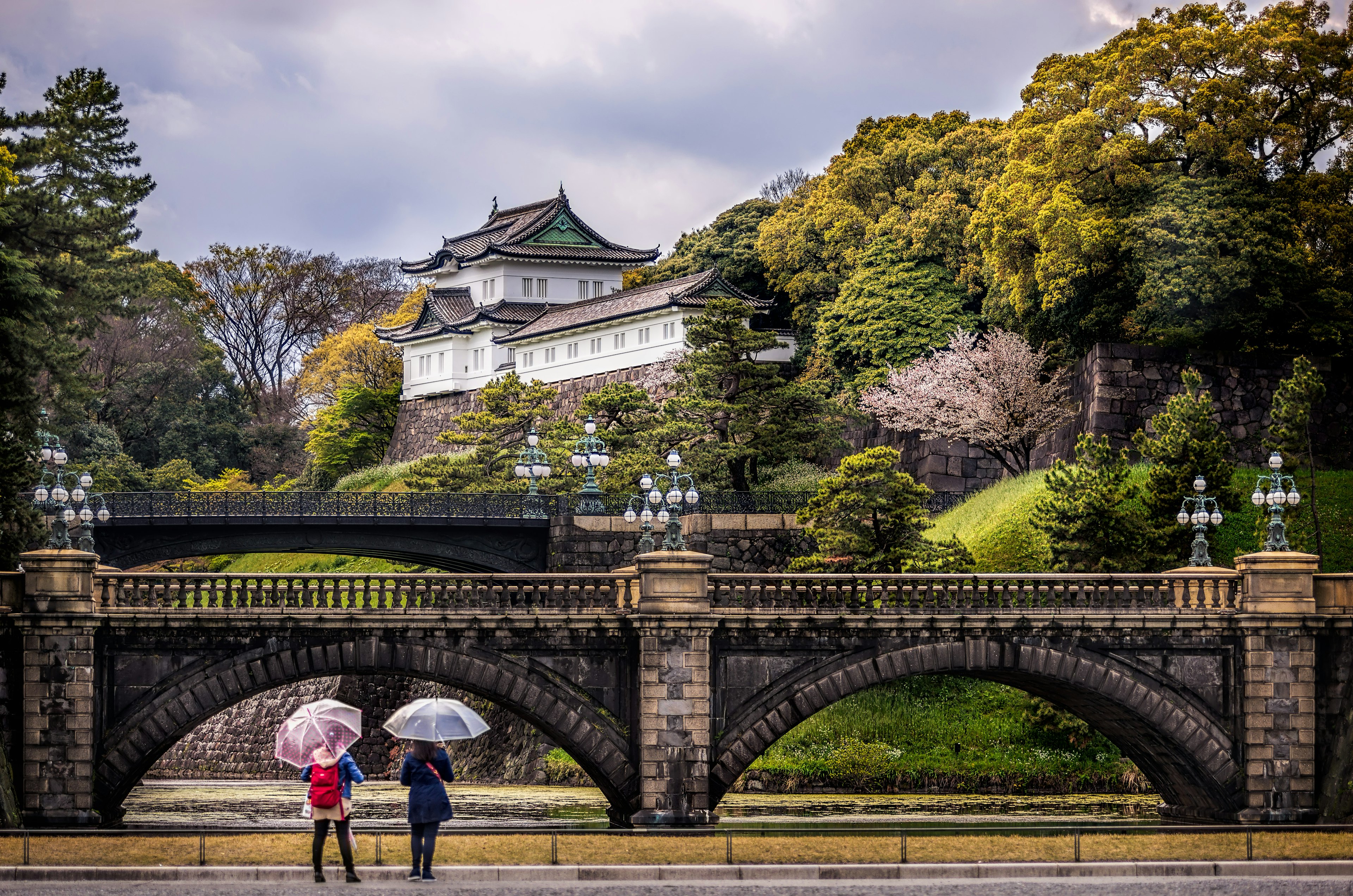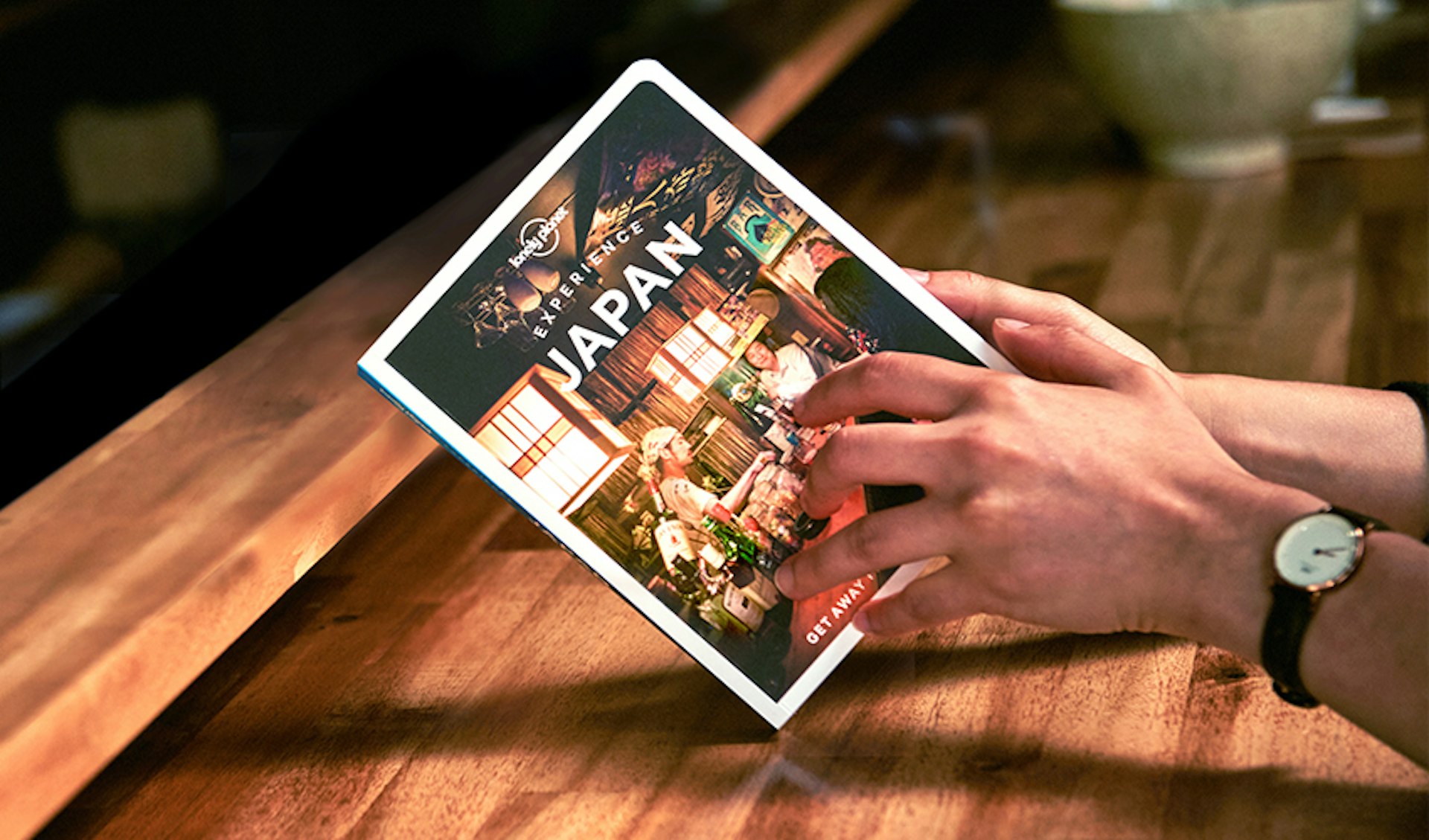More than any single sight, it’s Tokyo itself that enchants visitors. The city is a sprawling, organic thing, stretching as far as the eye can see. Tokyo is always changing, and with its diverse collection of neighborhoods, no two experiences of the city are ever the same.
Some areas feel like a vision of the future, with ever taller, ever sleeker structures popping up each year. Other neighborhoods evoke the past, with low-slung wooden buildings and glowing lanterns radiating surprising warmth along their laneways. Elsewhere, drab concrete blocks hide edgy art galleries and cocktail bars and every sidestreet hints at possible new discoveries.
In Tokyo you can experience the whole breadth of Japanese culture, from sumo wrestling and kabuki theater to cutting-edge contemporary art and, on a more playful note, giant robots and anime characters.
Here are the best neighborhoods to explore on a visit to Tokyo. We recommend picking just a couple of areas close together to explore in one day. The city is huge and while public transport is effortlessly smooth, you don’t want to spend half the day getting around.
Marunouchi and Nihombashi
Best neighborhoods for being in the heart of Tokyo
Most visitors to Tokyo are naturally drawn to the city's geographical and cultural centerpiece, the Imperial Palace. You can happily pass a day exploring this historic complex and the surrounding streets. Immediately east of the palace, the high-powered business district of Marunouchi has blossomed in the past decade, with a slew of new and revamped buildings housing high-end hotels, shops and restaurants.
Tree-lined Naka-dōri has morphed into one of Tokyo's most pleasant thoroughfares – the ideal way to saunter from Tokyo Station's handsomely reappointed red-brick frontage to Yūrakuchō, taking in the dramatic architecture of the Tokyo International Forum on the way.
Historic Nihombashi is the bridge from which all distances to Tokyo are measured. A pleasant morning or afternoon can be devoted to browsing the elegant Mitsukoshi and Takashimaya department stores, along with the Coredo Muromachi shopping, dining and entertainment complex.
If you work up an appetite, many Marunouchi landmarks have restaurant and food floors packed with options – try the Shin-Marunouchi Building or the KITTE Marunouchi shopping complex. With millions of travelers passing through, Tokyo Station offers all kinds of quick and easy meals as well as bentō (boxed meal) sets, which are great for train journeys or picnics in the Imperial Palace East Garden.
Nihombashi, the location of Tokyo's original fish market for 3400 years, is also a top culinary destination, with many venerable gourmet food shops and restaurants. Being mainly business districts, Marunouchi and Nihombashi are not big spots for a night out, although plenty of bars and casual pub-restaurants are dotted around.
Where to stay in Marunouchi and Nihombashi: With central Tokyo Station at its heart and the imperial family as neighbors, the prestigious Marunouchi and Nihombashi neighborhood doesn't come cheap. Book a night at Hoshinoya Tokyo for a luxurious ryokan (traditional Japanese inn) experience right in the center of the city.
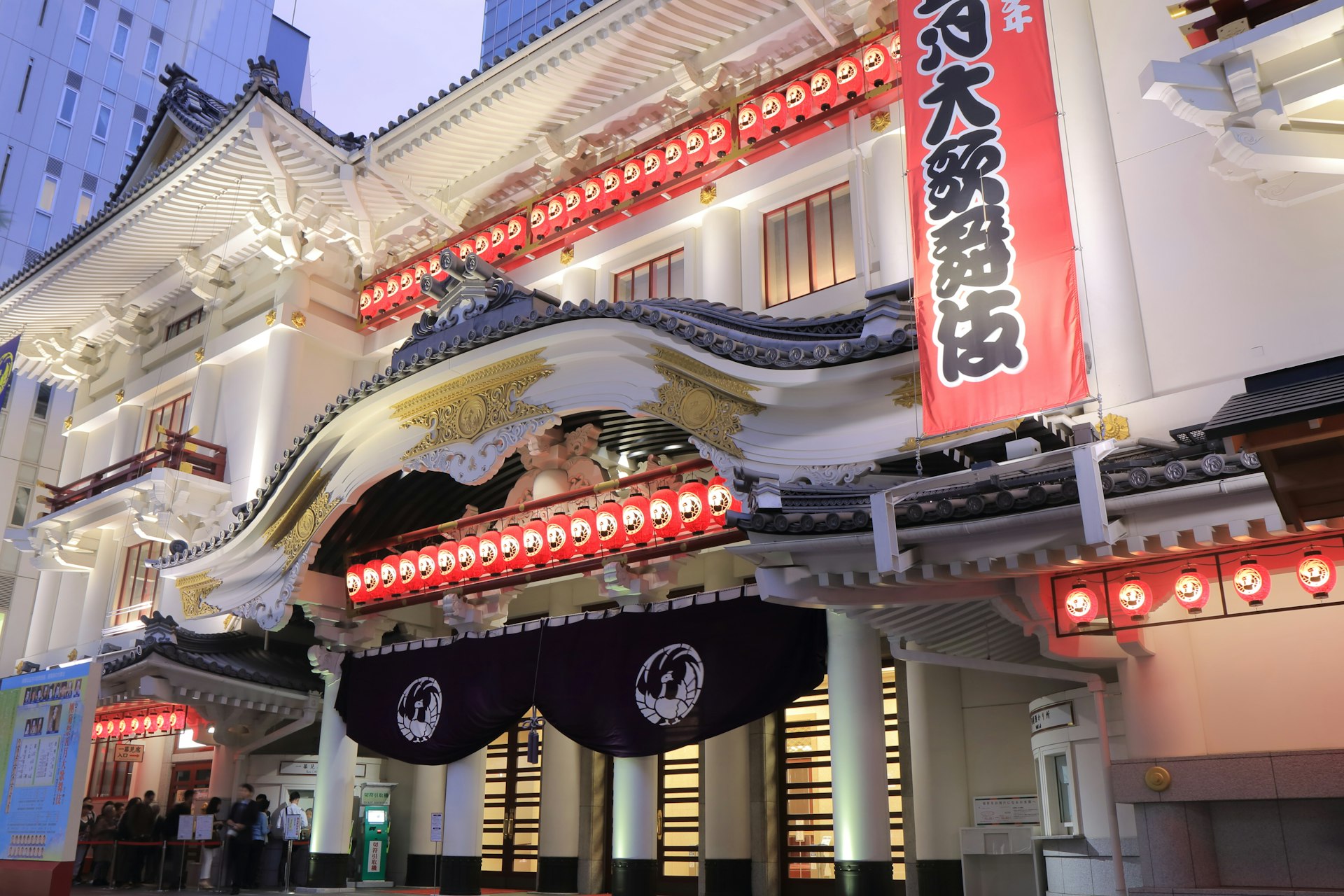
Ginza and Tsukiji
Best neighborhood for upscale shopping
Ginza is Tokyo's most polished neighborhood, a luxury fashion center resplendent with chic department stores, art galleries and exclusive restaurants. Proudly ranking alongside Fifth Avenue and the Champs-Élysées, Ginza is one of the most famous shopping strips in the world. It's a compact area, but you could easily spend a day here sashaying from Mikimoto Pearls and Louis Vuitton to Uniqlo.
Ginza is also strong on small commercial art galleries and creative spaces sponsored by major corporations such as Sony, Nissan and Mitsubishi. A major attraction is the city’s dedicated kabuki theater, Kabukiza, dedicated to Japan's ancient tradition of dance-drama. The fantastical facade – a contemporary reimagination of a traditional Japanese theater – is worth a look even if you're not drawn inside by the plays performed here.
The famous wholesale fish, fruit and vegetable market at nearby Tsukiji shifted across Tokyo Bay to a new home in Toyosu in 2018. However, the area is still well worth visiting for the mouthwatering array of food-related businesses that still fill the area around the old Tsukiji marketplace (formerly known as the “Outer Market”).
Ginza is famed for its high-end sushi counters, but amid the expense-account establishments there are also plenty of more affordable dining and drinking options, including classy ramen bars. Ginza's tiny and exclusive bars can easily bleed your wallet dry (should you manage to gain access in the first place). Never fear, though, as there are affordable places to drink the night away as well; look for bars under the railway tracks from Yūrakuchō to Shimbashi.
Where to stay in Ginza and Tsukiji: Ginza's central location and high-class reputation generally means pricey hotels, including, naturally, the elegant Imperial Hotel – Tokyo’s original deluxe accommodation, famous for its impeccable service. However, there are also some affordable business hotel chains and capsule hotels catering to travelers on a budget.

Roppongi and Akasaka
Best neighborhood for nightlife
Legendary for its nightlife, Roppongi is anchored by the chic Roppongi Hills and Tokyo Midtown complexes, where you'll find several excellent art museums, including the prestigious Mori Art Museum. To the south, you can't miss the city’s most famous symbol, the Tokyo Tower (it's nearly the same International Orange color as the Golden Gate Bridge in San Francisco), and nearby are a couple of venerable temples.
A short walk northeast is sophisticated Akasaka. Being close to Japan's parliament in Nagatachō gives Akasaka's watering holes an upmarket cachet. You'll also find a major Shintō shrine here, as well as an imperial palace and several Japanese gardens.
Roppongi and Akasaka are stacked with restaurants serving both Japanese and international cuisine. There's no need to slum it if you are on a budget; both Roppongi Hills and Tokyo Midtown complexes have many affordable eating options to suit all tastes. After dark, bars and nightlife are what Roppongi and Akasaka are all about – you'll have no problem locating a place to enjoy a booze-up or go wild dancing.
Where to stay in Roppongi and Akasaka: Both Roppongi and Akasaka are great places to be based, with good transport connections and a wealth of top-class eating, drinking and shopping options on the doorstep. Go high-end at the newly renovated Hotel Ōkura or check out Kaisu, a stylish hostel in a former ryōtei (traditional banquet hall) where geisha once entertained guests. There are also plenty of mid-range business hotels.
The best times to visit Tokyo: from spring cherry blossoms to winter lights

Ebisu and Meguro
Best neighborhood for lovers of peace and quiet
Ebisu and Meguro are gateways to a series of residential districts (some artsy, some upscale, some both) where Tokyo takes on a more human scale. The sights here are smaller and generally less crowded than those in the center.
There are some excellent art museums in Ebisu and Meguro, including the TOP Museum (the city’s photography museum) and the Tokyo Metropolitan Teien Art Museum. Trend-setting boutiques abound in Daikanyama and Naka-Meguro. Bookmark this area for a day when you're looking to take it easy, and set aside time for a stroll along the cherry tree-lined canal, Meguro-gawa.
After hours, Ebisu has a dynamic dining and bar scene that's worth checking out even if you pass on the sights. In fact, this is the one occasion where you may have to contend with crowds – popular restaurants and bars are packed most nights of the week. The lively Ebisu bar scene is particularly popular with young professionals; most places to drink are small (sometimes little more than a service counter) and it's fun to bounce from one to the next.
Where to stay in Ebisu and Meguro: Ebisu and Meguro are both stops on the convenient Yamanote train line, and you'll avoid the overwhelming crowds and disorienting sprawl of Shinjuku and Shibuya. Both make great bases for travelers, but unfortunately there are few places to stay beyond ordinary business hotels.

Shibuya and Shimo-Kitazawa
Best neighborhood for youth culture
Shibuya hits you over the head with its sheer presence: the continuous flow of people, the glowing video screens and the tangible buzz. All of this energy is perfectly summed up by its top attraction, the busy junction known as Shibuya Crossing. This neighborhood is currently undergoing a massive transformation, evidenced by new developments such as Shibuya Stream, marking the junction of two buried Tokyo rivers. A short train ride away, Shimo-Kitazawa offers a vision of what Tokyo might look like if hippies not bureaucrats ran the city.
Shibuya is a neighborhood that warrants a late start. Come for lunch or later – Shibuya is, above all, an entertainment district and it really comes alive at night. There are dance clubs, live-music venues, theaters and movie theaters galore. While weekends are the busiest, you’ll find people from all over Tokyo here any night of the week (and you may find yourself drawn back night after night by bars and karaoke parlors that stay open until dawn).
If you're keen to immerse yourself in urban Tokyo and its nightlife, Shibuya makes for a great base, and it's got great transport links, too. For food, hang out around Shibuya Center-gai, which is packed with fast-food joints, cheap izakaya (informal bars) and chain restaurants aimed at a younger, cash-strapped crowd – not a bad thing!
Where to stay in Shibuya and Shimo-Kitazawa: Shibuya has some good accommodation options, among them boutique hotels (such as Mustard Hotel), flash-packer hostels (such as Turntable) and cabin-style capsule hotels (such as Millennials).
An insider’s guide to getting around in Tokyo
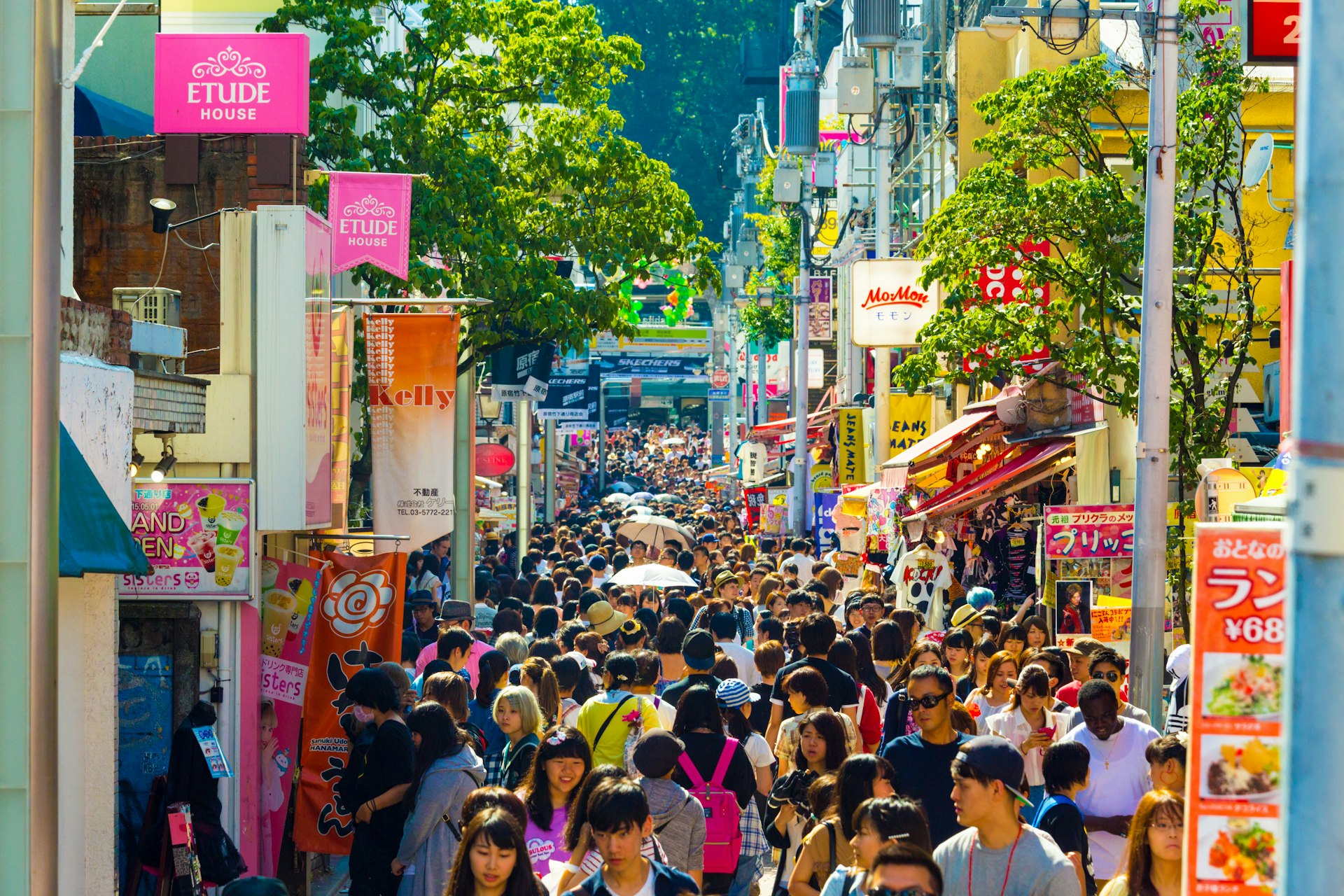
Harajuku and Aoyama
Best neighborhood for boutique shopping
Harajuku is one of Tokyo's biggest draws thanks to the grand 20th-century shrine, Meiji-jingū – one of Tokyo's top sights. It's also Tokyo's real-life catwalk, a world-renowned fashion destination where the ultra-chic (and chic in training) come to browse and be seen. Neighboring Aoyama, meanwhile, is a shopping and dining district for the city's fashionable elite. Many boutiques in both districts – and along the boulevard, Omote-sandō, that runs between them – have been designed by influential architects.
Harajuku is a neighborhood that rewards an early start. Meiji-jingū can get very busy, so the earlier you get here, the more likely you are to experience the kind of serene atmosphere that does the shrine justice. Shopping is, of course, a major attraction for many, locals included.
Harajuku is famous for being the location where foreign franchises drop their first Tokyo outlet, which usually attracts a lot of media buzz and some huge lines. There are boutiques from major Japanese fashion brands in Aoyama and edgier looks can be found in the boutiques among the winding side streets on either side of Omote-sandō. Then there's the trendy teen shopping strip, Takeshita-dōri, which by late afternoon will be positively packed with the young and hip.
As you'd expect from a trendy shopping district, Harajuku and Aoyama have lots of great, inexpensive lunch spots covering a variety of cuisines. Both neighborhoods become pretty quiet after the shops close for the day; there are a handful of places with glowing windows after dark, but you have to know where to find them.
Where to stay in Harajuku and Aoyama: These two districts have very few sleeping options, which is a shame because both would otherwise be attractive places to stay, with lots of cafes and restaurants and good transportation links on both the JR Yamanote line and the subway. There’s a convenient, no-frills Dormy Inn (a popular chain) in Harajuku, or you can try nearby Shibuya, which has more options.

West Tokyo
Best neighborhood for going local
During the boom years of the 1960s, the neighborhoods west of Shinjuku were developed as commuter towns for the capital's rapidly expanding population, with connections to the center on the Chūō train line. Today they feel like time-capsules of mid-20th-century architecture and urban planning.
Neighborhoods such as Nakano, Kōenji, Asagaya and Nishi-Ogi are immensely popular with counter-culture types who reject the constant construction and upward trajectory of the city center. Their tastes are reflected in the eclectic shops, restaurants and bars found here.
What makes this part of Tokyo so fascinating is that each of the neighborhoods has developed its own unique culture. Nakano is popular with otaku (fans of anime and manga) while Kōenji, just one stop away, attracts street artists and social activists.
As these are largely residential districts, there are few must-sees; exploring this area is more about getting a feel for how Tokyoites see Tokyo. The one big attraction out here is the enchanting Ghibli Museum, dedicated to Japan's most famous animated movie studio.
Given that these are residential neighborhoods, it would be tempting to write them off as sleepy; however, they are anything but. Each has its own nomiyagai (eating and drinking area) that draws locals in the evenings. Of all the districts on the Chūō train line, Kōenji has the most going on after dark, with lots of shops that stay open late, plus restaurants, bars and live-music venues.
Where to stay in West Tokyo: Staying out west can save you a little money, as chain hotels are a little cheaper out here. It's also a chance for a more local experience, as these are largely residential neighborhoods. BnA Hotel in Kōenji, which has works by local artists on the walls, is our top pick here. Having to take the often-crowded Chūō line to get anywhere can be a drag, but it does give you direct access to hubs such as Shinjuku and Tokyo Station in Marunouchi.
21 of the best free things to do in Tokyo: from shrines to sumo

Shinjuku and Northwest Tokyo
Best neighborhood for all-day exploration
Shinjuku is almost a city within the city. Developed in the latter half of the 20th century, it's become synonymous with Tokyo itself. The breadth and scale of this post-war development are simply awesome – more than three million people pass through Shinjuku train station every day.
Clustered in and around this enormous train station are many department stores and electronics stores, which make easy work of shopping for souvenirs, plus plenty of restaurants and food courts. On the east side of the station, the grassy oasis of Shinjuku-gyoen is great for a picnic (and a breather); pick up snacks in one of the department store basement food halls.
Shinjuku works neatly as a day-to-night destination. Start with the skyscraper district of Nishi-Shinjuku – you'll have the streets to yourself if you come after 10am to avoid the morning rush. Morning is usually the clearest time of day and thus your best chance to see Mt Fuji from the observatories atop the Tokyo Metropolitan Government Building.
Shinjuku's east side, home to the city’s largest nightlife district, really shines at night, quite literally. Come here at dusk as natural light gives way to arresting artificial neon, and Tokyo becomes, for this magical hour, actually beautiful. There are myriad bars, izakaya, karaoke parlors, music spots and more to keep you entertained until dawn. While Friday nights are the most crowded, Shinjuku buzzes every night of the week.
Shinjuku is so large, in fact, that it contains multiple sub-districts. Shinjuku-nichōme is Tokyo's LGBTIQ+ enclave, Shinjuku-sanchōme is full of izakaya that are popular with commuters stopping off on their way home, and the tiny bars of Golden Gai are a draw for artists, musicians and, increasingly, travelers. Running through the middle of this is Yasukuni-dōri, the main artery, electrified with a thousand glowing signs.
Where to stay in Shinjuku and Northwest Tokyo: Shinjuku is a convenient base, popular with travelers and with options at all price levels. Splurge on a room at the sky-high luxury hotel, the Park Hyatt Tokyo, or hole up at hostel-slash-reading-room, Book and Bed. This neighborhood has a huge spread of eating options, and there's little you can't get here.
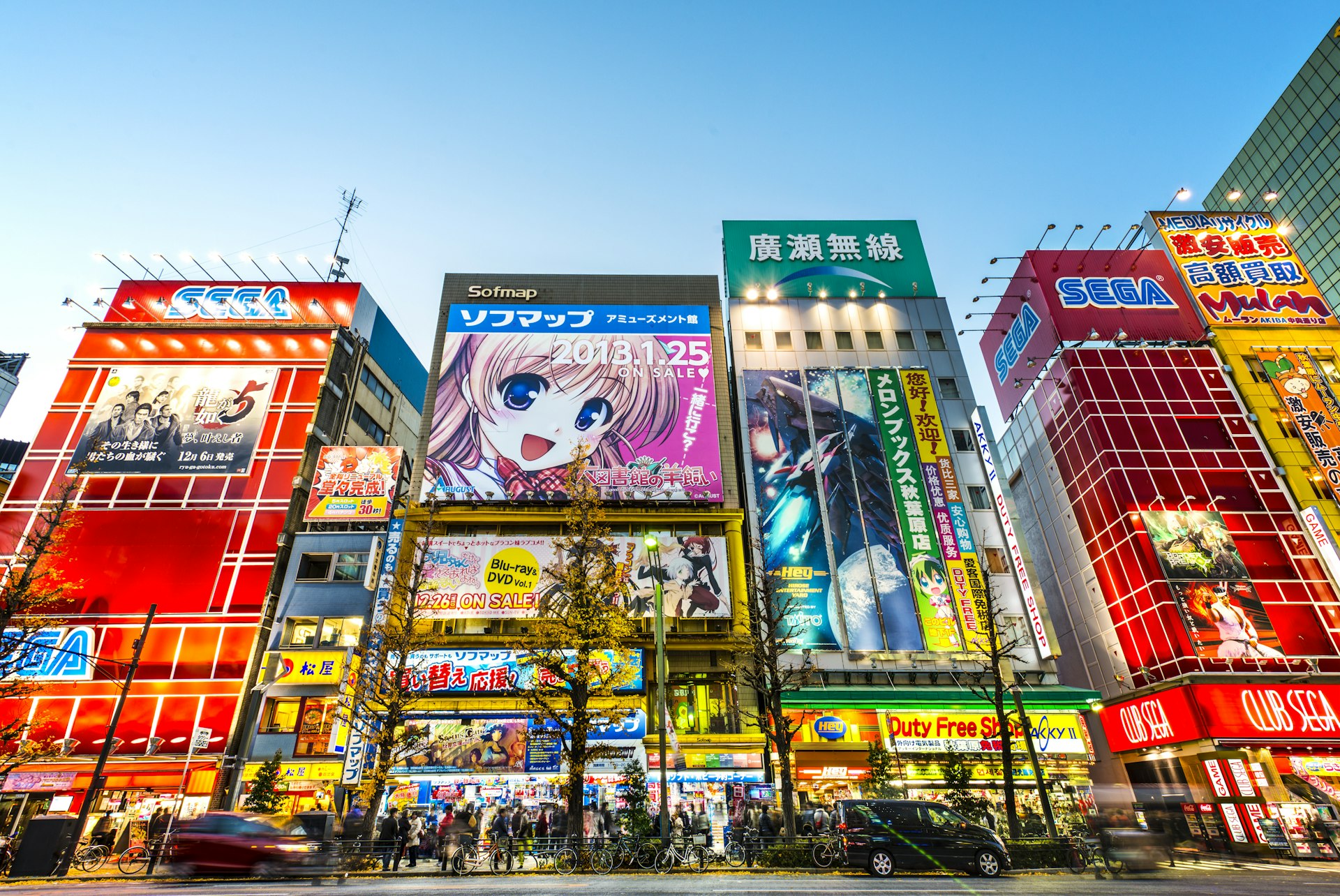
Kōrakuen and Akihabara
Best neighborhood for old customs and new trends
Kōrakuen and Akihabara occupy a swath of central Tokyo running alongside Soto-bōri, the former outer moat of Edo Castle, and the Kanda River, one of the city’s main waterways. To the west, there's the charming old geisha district of Kagurazaka, and the Kōrakuen area, home to the gorgeous traditional garden, Koishikawa Kōrakuen, and the Tokyo Dome baseball stadium. Further east, browse the bookshops of Jimbōchō, the traditional restaurants of Kanda, and the electronics, pop culture and contemporary-craft emporiums of Akihabara.
Kagurazaka has many exclusive, extravagantly priced restaurants, but there are some attractive affordable options too. Once a busy geisha teahouse area, this is now one of the most atmospheric parts of the city to wander around at night and find a nice cafe or bar.
Where to stay in Kōrakuen and Akihabara: Kōrakuen, Kanda, Kagurazaka and Akihabara are all central locations with good transport connections and great eating and nightlife on hand. This area has plenty of budget and mid-range accommodations, but for something truly unique, try the 1930s art deco Hilltop Hotel, a one-time hangout for the Tokyo literati.
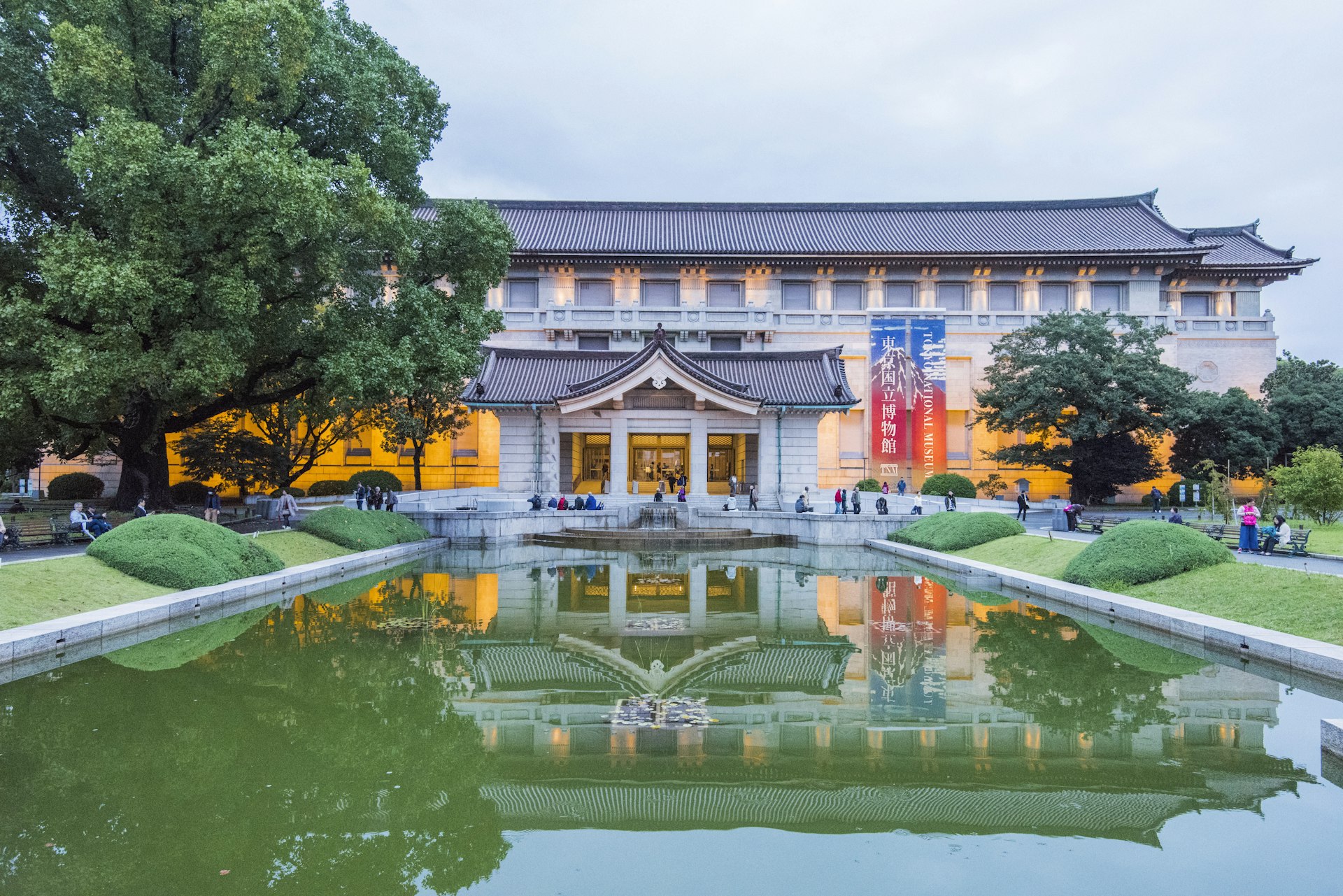
Ueno and Yanesen
Best neighborhood for museums
Ueno is the cultural heart of Tokyo. Its central park, Ueno-kōen, has the city's greatest concentration of museums, including the Tokyo National Museum. The neighboring areas of Yanaka, Nezu and Sendagi are collectively known as Yanesen – a charming part of Tokyo where it feels as though time stopped several decades ago. Transporting you even further back in time is the beautiful 17th-century strolling garden, Rikugi-en, the highlight of the Komagome area.
Ueno isn’t much of a culinary destination, although there are some lovely traditional restaurants in and around the park, and also in Yanesen. With the exception of the area immediately around Ueno Station, these districts are pretty quiet at night, though Yanaka has a few hip hangouts.
Where to stay in Ueno and Yanesen: As one of the major gateways into and out of Tokyo, Ueno is well stocked with business hotels – Nohga Hotel is the most attractive of the bunch. Yanesen, meanwhile, has Tokyo’s best selection of ryokan. Family-run Sawanoya Ryokan, which has a wonderfully welcoming vibe, has long been a traveler favorite.

Asakusa and Sumida River
Best neighborhood for tradition
On the banks of the Sumida River, Tokyo's eastern neighborhoods have an old-fashioned feel, with venerable temples and shrines, lovely gardens, traditional restaurants and artisan shops. Zone in on Asakusa's famously atmospheric Buddhist temple complex, Sensō-ji, and the sumo hotspot of Ryōgoku, home to the ancient sport's main Tokyo stadium and a top-class history museum, the Edo-Tokyo Museum.
Asakusa is one of Tokyo's principal tourist destinations, and during the day, it's pretty much jam-packed. If you step off the main drag though, you'll find fewer tourists, and the craft shops and small restaurants that have long defined these quarters. Walking around the peaceful neighborhoods east of the Sumida River gives a good feel for the culture of old Tokyo. These districts are not without their pockets of hipster cool either, thanks to cheaper rents compared to the city center.
Asakusa offers an abundance of street-food stalls selling unpretentious Japanese dishes, generally at modest prices. You'll also find some of the city's longest-running and most traditional restaurants here. Overall, this neighborhood is one of Tokyo's quieter areas for nightlife, and it gets even snoozier on the east side of the Sumida River.
Where to stay in Asakusa and Sumida River: Asakusa is Tokyo's budget-traveler center. If you're looking to meet up with other travelers, this is the best place to stay. There are loads of hostels to choose from – our favorite is Nui, whose first-floor cafe is a popular local hangout. There are also several business-class and tourist-oriented hotels here as well as some excellent ryokan. The main downside of staying in this area is its relative distance from other central Tokyo districts.
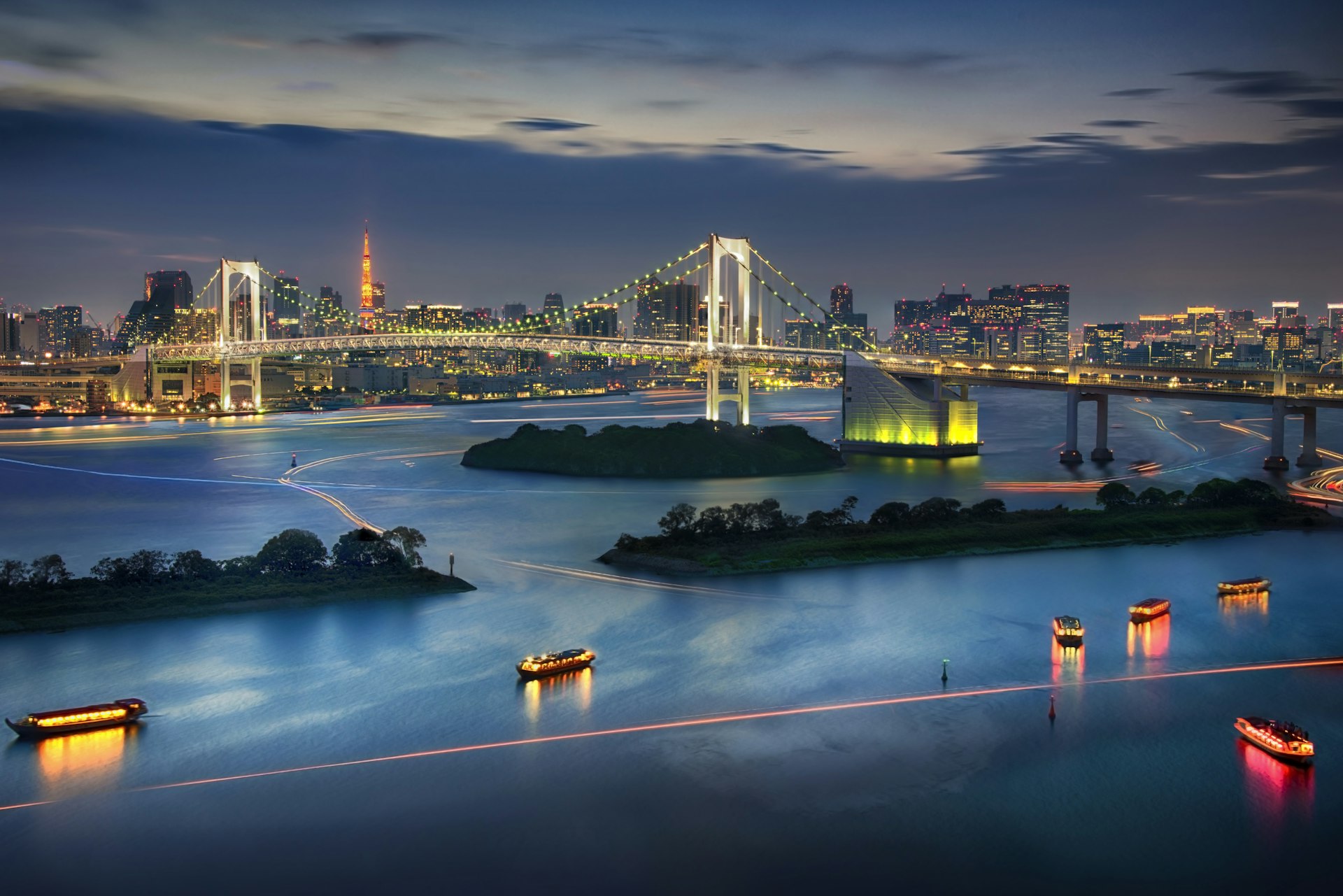
Odaiba and Tokyo Bay
Best neighborhood for families
In central Tokyo, it’s easy to forget that the city started as a seaside town. This is not the case in Odaiba, a collection of artificial islands on Tokyo Bay. One of Odaiba's biggest selling points – in addition to its views of the bay and the Tokyo skyline – is its family-friendly feel. Attractions include the hands-on National Museum of Emerging Science and Innovation (which has live demonstrations of humanoid robots), the augmented reality arcade Tokyo Joypolis, and a massive statue of the anime character Unicorn Gundam – perhaps the most only-in-Tokyo sight imaginable! Adjacent to Odaiba is the island of Toyosu, home to the city's new wholesale market, which replaced the iconic Tsukiji Market in 2018.
The best place to eat around Tokyo Bay is at the new Toyosu Market, which has several floors of restaurants – among them some truly excellent sushi shops (naturally), and some superior shokudō (inexpensive casual restaurants) and cafes. Odaiba's malls are packed with mostly uninspiring, but family-friendly food courts and chain restaurants. Odaiba is a daytime destination and has little to offer at night beyond expensive and somewhat old-fashioned hotel bars (which admittedly have good bay views).
Where to stay in Odaiba and Tokyo Bay: Accommodation options in Odaiba and around Tokyo Bay are limited to a few dated resorts and business hotels, though there are new developments in the works. Transportation from this district to the rest of the city is costly and tedious, so unless Odaiba is the focus of your visit, we recommend basing yourself elsewhere and visiting for the day.
You may also like:
21 of the best free things to do in Tokyo: from shrines to sumo
The best times to visit Tokyo: from spring cherry blossoms to winter lights
Anime, arcades and pop-culture artifacts: a geek’s guide to Tokyo

